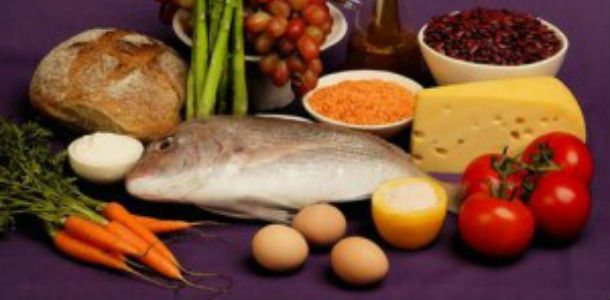Everybody knows about the benefits of good nutrition and try to make the body receives the necessary amount of fat, protein and carbohydrates. But there are other components, without which our health will deteriorate, although the number of these trace elements is calculated in very small doses.
Such trace elements as iodine, our body needs a day only 150-200 micro grams, and g – this is only a millionth of a gram. Over a lifetime, a person uses iodine is only one teaspoon, but the importance of it to the body is very high.

General characteristics of iodine
Iodine belongs to the group of halogens, and in the periodic table it is in the group of 17 at number 53. The word “iodine” has Greek roots and means “violet” or “purple”.That is called it French chemist J. Gay-Lussac for the color of its vapor.Iodine was discovered 200 years ago – in 1811 from chemist Bernard Courtois. Although the ancient Chinese healers for 3000 years BC, used iodine derived from seaweed, for wound healing.
In nature, iodine is found almost everywhere: in living organisms, soil, minerals, water, air. The largest number of trace elements contained in seawater – 0.06 mg / ml, and the air and soil in coastal regions. In the human body, iodine is supplied with food and air and accumulates in the thyroid gland, which is responsible for brain development and proper growth.
iodine and its biological properties in humans
Iodine – is a vital substance for normal functioning of the body. The main biological role of iodine in the human body – is involved in the synthesis tireoidalnyh thyroid hormones – thyroxine and triiodothyronine, enough of which has an impact on the important processes in the body.
- It provides and regulates metabolism.
- It regulates growth, development and reproduction of cells and tissues.
- It has impact on the cardiovascular system: regulates blood pressure and heart rate.
- Responsible for the normal functioning of the nervous system, mental state and emotional background.
- It helps normal growth and development of the organism.Participates in the formation of bone tissue, affects the mental ability.
- It has impact on the body’s resistance to bacteria and viruses.
- Adjusts the need for vitamins.
- It has an impact on the formation of the fetus during pregnancy.
Iodine helps reduce cholesterol levels. Many useful recipes for lipid-lowering diet will find on our site.
Read this article about the most popular methods for the purification of the blood vessels.
Iodine – is the substance that is responsible for the normal development and growth of a person, and it is difficult to imagine how would look like living beings, if this trace element was absent in nature.
The iodine is useful?
All we traditionally use iodine to disinfect wounds, but the properties of this trace element is truly universal.And at the right time it is able to provide our body invaluable assistance.
The body of a healthy adult contains 15-20 mg of iodine.
The World Health Organization recommends a daily drink with food the following amounts of iodine: pregnant women – 250 mcg per day for adults – not less than 150 mg, and children under 12 must be 90-120 micrograms.
- Iodine is necessary for normal functioning of the immune system.With enough of this trace element man full of energy, cheerful, energetic and cheerful.
- Iodine has an effect on mental development.It is necessary for normal brain function, helps maintain the excellent condition of memory to old age.Pregnant women need it for the formation of healthy and mentally grade child.
- This trace mineral has an impact on the condition of the skin, teeth, hair and nails.
- Preventive use of iodine preparations with 2 times per year reduces cholesterol in patients with atherosclerosis.
- In diseases of the throat and colds spend inhalation with iodine.
- blue iodine solution is useful in the treatment of dysentery, colitis, enterocolitis and stomach poisoning.
- Iodine is essential for improving lipid metabolism: it helps to eliminate cellulite and facilitates the process of burning fat while dieting.
- Iodine is used to treat diseases such as rickets, rheumatism, gout, and resolving the action of iodine is well known for the treatment of hematomas.
Symptoms of iodine deficiency in the body
According to the World Health Organization, 30% of the population of our planet, which is about 1.5 billion people, lack of iodine in the body. This means that they are at risk of developing diseases caused by iodine deficiency, and more than half a billion people already have the disease.
Most of the population live in regions where there is a lack of iodine.A sufficient amount of this trace element is obtained only by residents of the coastal areas.Their diet is dominated by fish and seafood, and the air and sea water is high concentration of this trace element.
To determine the lack of iodine in the body, it is necessary to conduct blood test for thyroid hormones.
But at home, you can see how things are going with iodine in your body. To do this, carry out a simple test is enough.
Evening in the forearm with a cotton swab strip 3 must hold:. First width and 5 mm, the second – 1 cm, and the third – 1.5 cm morning look at the results.If the three bands disappear very narrow, the iodine in your body is enough.If there is broad, and the other two disappear, it speaks about iodine deficiency.If no trace in the morning on all three bands, then it is iodine deficiency, and it is necessary to take urgent measures.
To my body needs to look closely and listen to just pay attention to the symptoms of iodine deficiency in the body:
- A feeling of fatigue, weakness, drowsiness, lethargy, seizures, depression.
- Memory impairment is a common symptom of a lack of iodine in the body.
- The character of a person for no apparent reason changed for the worse: he becomes irritable, aggressive.
- The skin becomes dry, brittle hair, nails exfoliate.
- It appears overweight.
- Constantly pursued feeling cold.
- It appears swelling, fluid is retained in the body.
- The voice becomes hoarse.
One of the symptoms of iodine deficiency is overweight. Oatmeal diet for weight loss will not only help you stay in shape, but also save your health.
Diet of squash that is described in this article , is also an effective and safe method to get rid of extra kilos.
In addition to the external signs of iodine deficiency in the human body begins to disturb and physical condition:
- Develops an arrhythmia.
- Sudden changes in pressure.
- Increased cholesterol levels in the blood.
- Develop chronic constipation.
- Reduced intellectual capacity.
The first symptoms of iodine deficiency on the thyroid condition. Feeling “hunger”, it begins to work harder, but it leads to its increase – the development of such diseases as iodine deficiency goitre.
The excess of iodine in the organism – Symptoms
The organism feels all right, when it contains the required amount of vitamins and minerals, including iodine.As a disadvantage, and excess of this substance is harmful to the body, but an excess is extremely rare.
Symptoms of excess iodine is the development of hyperthyroidism or thyrotoxicosis, that is, the thyroid gland produces more hormones than the body needs.As a result, they can develop diseases such as hyperthyroidism, exophthalmos, and tachycardia.
Most often, an overabundance of iodine in the body cause such reasons:
- Excessive intake of this trace element (upper margin is considered the consumption of up to 500-600 mg per day).
- Dysregulation of iodine metabolism.
The overabundance of iodine is manifested by the following symptoms:
- Sudden weight loss, because the metabolism is accelerated.There is a tendency to diarrhea.
- Conjunctival irritation and airway mucous.The result is a watery eyes, coughing, sore throat.
- Finger tremor, increased heart rate.
- The body temperature rises above 37.5 degrees.
- It appears sweating, muscle weakness.
- The person becomes very irritable.
- Hair turns gray prematurely.
- It occurs individual skin pigmentation.
- In the mouth there is a metallic taste.
- Immunity is weakened, and as a result the body is exposed to frequent colds and viral diseases.
It is important to remember that without a doctor’s advice to take iodine-containing products is not recommended, as it can easily exceed the permitted limit and hurt his thyroid gland.
What foods contain iodine
The iodine in our bodies comes only from the outside, and the amount depends on how they are rich in products included in our diet.
Many believe that by replacing conventional iodized table salt, they decide for your body’s iodine deficiency problem.But iodized salt is not a panacea that can replace other sources of iodine.Especially since the opened package for 2 months loses half it contains essential trace elements.
A rich source of iodine, is water.One liter of drinking water comprises up to 15 mg of such compound.
In sea water there are large reserves of iodine, so its inhabitants in their bodies accumulate a large amount of it.Shrimp, squid, crabs, mussels, oysters and scallops are not only tasty, but extremely useful.100 g of these specialties contain from 300 to 100 mcg of iodine.But, unfortunately, so replenish stocks of iodine can not everyone.
More iodine has sea fish stocks (from 190 to 50 micrograms), and freshwater, but also prone to heat treatment, is poor in this trace element – 5-10 mcg.
Iodine is found in foods that every day we include in their menu – it’s milk, eggs, butter, pork and beef, bread, cereals.
Small amounts of iodine contained in fruits and vegetables: potatoes, eggplant, garlic, tomatoes, onions, bananas, persimmons, oranges and strawberries.With their use, we get the required amount of iodine.
Which products has more iodine
The greatest number of foods rich in iodine, we deliver the sea.And leading position among the foods high in iodine occupy brown seaweed – kelp.100 g of this product contains 300 mg of iodine.The daily use of 2 tablespoons of seaweed body will compensate shortage of such essential trace elements.
Also kelp, rich in iodine and salt-water fish. Heck, pollack, haddock, cod, bass, capelin, salmon, tuna and flounder contain from 160 to 50 micrograms of the trace element. Just 150 grams of hake able to meet the daily requirement of iodine.
Among the seafood (oysters, shrimp, scallops and other) by the number of contained iodine squid lead – up to 300 micrograms per 100 grams of product.
Other products are much poorer than iodine.So among dairy products 16 micrograms found in milk and millet groats (4 g) is the leader among cereals.
On the iodine content of this subtropical fruit is pineapple guava, the opinions of scholars dispersed.Some believe that the fruit does not contain iodine, while others argue that the content of this trace element feijoa even ahead of kelp – 350 CIM.
Dry hair damage – is an indication of a lack of iodine in the organism. Burdock oil for hair can help deal with this problem.
